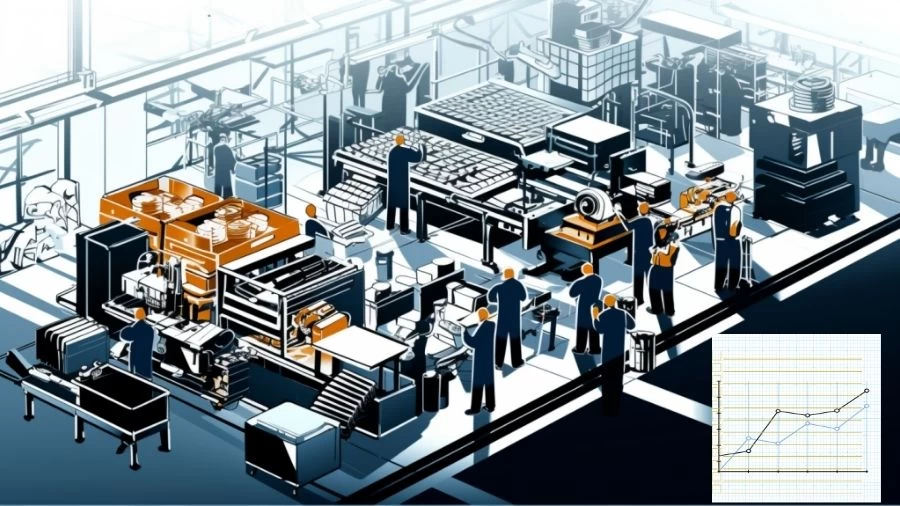
What is the Producer Price Index and Why it is Important?
The Producer Price Index (PPI) is a key economic indicator that provides valuable insights into the ever-changing landscape of prices for goods and services produced in the United States.
Published Sep 15, 2023 | Updated Sep 15, 2023 | 📖 6 min read
What is the Producer Price Index?
The Producer Price Index (PPI) is a way to see how much prices change for things made in the United States. It looks at prices before they reach regular shoppers. The PPI is important because it helps us understand if things are getting more expensive for the companies that make stuff. It's different from the Consumer Price Index (CPI), which shows how much things cost for regular people.
The PPI is published every month by the Bureau of Labor Statistics. It helps businesses, economists, and policymakers keep an eye on inflation and understand how the economy is doing. They use it to see if prices are going up or down for the things companies need to make their products.
Why is PPI Important in Economics?
The Producer Price Index (PPI) is important in economics because it helps us understand how prices change for goods and services right from when they're made. It's like a signal for inflation, which is when things get more expensive. Economists use the PPI to adjust other data and figure out how much things are really worth, without the effect of inflation.
For example, it helps them calculate things like the Gross Domestic Product (GDP) in terms of constant dollars, which is a measure of how well an economy is doing. When the PPI goes up a lot, it can mean inflation is happening, which could lead to higher interest rates. This, in turn, can affect how the stock market behaves and how people make decisions about money. So, the PPI is like a tool that helps us keep an eye on the economy and make important financial decisions.
How is the PPI Calculated?
The Producer Price Index (PPI) is calculated using different formulas, but one commonly used formula is the Laspeyres Index. This formula compares the prices of goods and services in the current year to their prices in the base year. Here's how it works:
PPI (Laspeyres) = (Sum of quantities in the base year × Current year prices) / (Sum of quantities in the base year × Base year prices) × 100
In simpler terms, it calculates the average change in prices for a set of goods and services over time. For example, if the base year had 100 widgets at $1 each, and in the current year, the same 100 widgets cost $1.10 each, the PPI would be (100 × $1.10) / (100 × $1) × 100, which equals 110. This means prices have gone up by 10%.
The PPI can be calculated using other formulas like the Paasche or Fisher formula, which consider different factors like quantities and prices in the base and current years. The choice of formula depends on the specific needs of the analysis, but the Laspeyres formula is commonly used by the Bureau of Labor Statistics (BLS) to calculate the PPI.
Difference of Producer Price Index (PPI) and the Consumer Price Index (CPI)?
|
Producer Price Index (PPI) |
Consumer Price Index (CPI) |
|
Measures price changes at the wholesale/producer level. |
Measures price changes at the retail/consumer level. |
|
Tracks changes in prices of goods and services before they reach consumers. |
Tracks changes in prices of goods and services as experienced by consumers. |
|
Includes prices paid by producers for inputs, intermediate goods, and final products. |
Includes prices paid by consumers for everyday goods and services. |
|
Used by businesses to anticipate production cost changes. |
Used by consumers to understand changes in the cost of living. |
|
Typically published monthly by government agencies. |
Also published monthly by government agencies. |
|
Can influence business decisions and production planning. |
Can influence monetary policy decisions, such as interest rates. |
How Does the PPI Influence Inflation Analysis?
The Producer Price Index (PPI) plays a crucial role in analyzing inflation. It looks at how much it costs for businesses to make products, and this can give us a hint about future inflation. If the PPI goes up, it might mean that prices for consumers will go up later. Inflation is important because it tells us how fast prices are rising for the things we buy every day.
In a healthy economy, prices go up a little bit each year, but if they go up too fast, it can be a problem. Central banks, like the Federal Reserve in the United States, use inflation data to decide how to set interest rates. High inflation might lead to higher interest rates, which can affect things like loans and savings. So, the PPI is like a clue that helps us understand what might happen with inflation, and that's important for everyone, from regular people to investors and policymakers.
How to Business Use PPI Data?
Businesses can use PPI data to adapt to changing economic conditions. When the PPI goes up, it means that the cost of making products is rising. This can lead to higher prices for consumers down the road. To deal with this, managers can look for ways to streamline operations and reduce costs. One way to do this is through automation, like using software to handle tasks more efficiently.
For instance, tools like Stampli's AP Automation can make processing accounts payable faster and more cost-effective. By staying informed about economic indicators like the PPI, businesses can make smart decisions to navigate challenges and make their operations more efficient.
Core PPI vs Headline PPI
Core PPI and Headline PPI are like two different ways of looking at prices to understand inflation.
Headline PPI: This one includes all kinds of prices, like food and energy. It's like looking at the entire menu when you're at a restaurant. It tells us how much prices are changing for everything in the economy. But because food and energy prices can jump up and down a lot, it can make the inflation number seem more bumpy.
Core PPI: Now, this one takes out the prices of food and energy. It's like looking at the menu, but skipping the food and drinks. Why? Because food and energy prices can be really wobbly, and they change for all sorts of reasons, like weather or international stuff. So, some economists like to look at Core PPI to get a smoother picture of how prices are changing. It helps them see the trend in inflation without the noise from food and energy prices.
Classification of PPI
Industry-Level Classification: This categorization looks at how prices change for the total output of an industry. It focuses on the overall sales price of the products an industry produces and sells outside of its own sector.
Commodity Classification: Here, the PPI groups products and services based on their similarity, composition, and use. It helps identify and separate different products within an industry.
Final Demand - Intermediate Demand (FD-ID) Classification: This classification is based on who uses the products and services. When the end-users are the customers themselves, the price changes are categorized as "final demand." However, if the products and services go through intermediate channels before reaching customers, the price changes are labeled as "intermediate demand.
What is the Producer Price Index - FAQs
1. What is the Producer Price Index (PPI)?
PPI is a measure of price changes for goods and services at the wholesale level.
2. How is PPI different from the Consumer Price Index (CPI)?
PPI tracks wholesale prices for businesses, while CPI measures retail prices paid by consumers.
3. Why is PPI important for businesses?
PPI helps businesses anticipate changes in production costs and plan for potential price increases.
4. How often is PPI data released?
PPI data is typically published monthly by government agencies.
5. How can investors use PPI information?
Investors use PPI data to gain insights into inflation trends and make informed decisions about financial markets.




